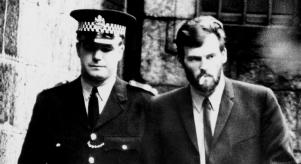
When serial killers write tell-all books
Lady Chatterley’s Lover. Tropic of Cancer. Lolita. The Satanic Verses. The history of controversial books is a long and varied one. Usually, it’s the theme of the book that stirs up a reaction. As you can imagine, it’s sex and religion which tends to get the biggest response. Often, but not always.
In 2001, word broke of a book that was due to hit printing presses, released by the leftfield American publisher Feral House. The esoterically-entitled ‘The Gates of Janus’ was a work written by Ian Brady. The Moors Murderer Ian Brady. Hence the controversy (that only really died down as of September 11th of that year, for fairly obvious reasons).
The tabloids exploded when news of Brady’s upcoming book first leaked. Imprisoned for decades for killing five children in the early 1960s, Brady and his accomplice and girlfriend Myra Hindley had refused to tell police the whereabouts of some of their victims’ burial sites. To call Ian Brady the most hated men in Britain was, at the time, more than a fair description.
The idea of giving such a man a platform seemed, to many, to be obscene. To others, it seemed an unmissable opportunity to gain invaluable insight into the mindset of a psychopathic killer. The book was, in the end, published. Unsurprisingly, it wasn’t exactly a Times bestseller and now resides on the shelves of only the most curious and open-minded crime buff.
Brady isn’t the only multiple murderer to put pen to paper, however. In fact, a surprising amount of serial killers have written books. Let’s examine some of the more interesting works here. We start with The Gates of Janus itself...
The book was due, originally, to be put out under the pseudonym ‘François Villon’, after a fifteenth-century French poet who used to write boastful poems about his own criminal behaviour back in the Middle Ages. This rather high-falutin’ reference gives an insight into Brady’s writing style, influences and outlook.
At times almost testingly academic, Ian Brady demonstrates an aptitude for writing that most writers would covet. Although in need of an editor, the Scot clearly thinks a lot of himself (narcissists generally do) and his writing (which, to be fair, is quite extraordinary in places).
Brady analyses eleven serial killers and their actions
The Gates of Janus is not, as some expected, an autobiography. In fact, there are barely any explicit references to Brady or his crimes. Any insight into the man needs be gleaned from understanding his world viewpoint and opinions instead.
It’s a work of two distinct halves. The first portion is effectively a diatribe; a postulation on the merits of his interpretation of ‘moral relativism’. It’s a philosophical position that Brady was obsessed with. The basic tenet, as he saw it, is that morality is cultural and shifting and no one can rightfully judge the actions of another. It’s clear from his writing that he was unrepentant for his crimes, essentially claiming that he wasn’t ‘wrong’ to commit them, given that ‘wrong’ cannot truly exist.
While an interesting idea explored by such luminaries as the German philosopher Friedrich Nietzsche for pretty much his entire career, nihilistic philosophical standpoints like these don’t tend to hold much water in courts of law or public opinion.
The second half of the book is far more interesting. Brady analyses eleven serial killers and their actions, suggesting specific motivations behind their MOs and behaviour. It’s a unique perspective, of course. Some critiques are on the nose, while others seem like half-arsed pieces of guesswork padded out with cod psychology.
He assesses the criminal careers of infamous murderers such as Ted Bundy, Richard Ramirez, Peter Sutcliffe and Henry Lee Lucas. The most entertaining chapter concerns itself with the oddly under-reported and mostly unknown case of The Mad Butcher of Kingsbury Run (aka The Cleveland Torso Murderer), an unidentified serial killer that terrorised the slums of Ohio in the 1930s. Brady lends potentially vital information as to a potential suspect, albeit while knowing full well that he’d never be proven either right or wrong.
Sample Quote: 'The most salient traits of the psychopath are coldness, calculation, manipulation, lack of sensitivity, natural deviousness, facile mendacity, amorality presented as moral flexibility, pathological anger and envy rationalised as altruism or logic, all-encompassing greed, assumption of personal superiority over all others, a dictatorial and bullying attitude relying on power and authority rather than intelligence, suspicion and lack of trust to a paranoid degree, inexorable ruthlessness, an egocentric conviction that they are always right, sexual promiscuousness and a complete lack of remorse.
'Does any combination of these features remind you of someone in your household, a relative or friend, a person at your place of work, a politician, a bureaucrat, some minor official, a judge, a teacher, an author or journalist, a member of the armed forces or the police, some person with practically everything they could possibly need but who always wants more? Or even yourself...?'
One of the more interesting, if rather more unsubstantiated books ever penned by a serial killer comes from a man who should probably be a good deal more infamous than he is. Donald Henry ‘Pee Wee' Gaskins Jr. is known to true crime fans and serial killer aficionados, but the self-proclaimed 'Meanest Man in America' never quite found widespread notoriety.
There's no denying or refuting that Gaskins was a bad man. Fried by the state of South Caroline after being found guilty of nine murders, he was a stone-cold criminal; a violent thief, a rapist and a killer. But, however, he was also something of a braggart and fantisist. While awaiting execution on Death Row, Gaskins told his life story to a writer called Wilton Earl, who would help bring Final Truth to the page. But just how much of it is to be taken as Gospel?
The book is not for the faint-hearted. Brutal, unflinching and told in the first person, it's widely thought that it's littered with lies, half-truths and huge bouts of self-aggrandisement. Still, if only a quarter of the tales told are true, his was some life. A life of unrelenting savagery and cruelty from the very beginning to the very end.
Sample Quote: 'I am one of the few that truly understands what death and pain are all about. I have walked the same path as God. By taking lives and making others afraid of me, I become God's equal. Through killing others, I become my own master. In this book, I'm not asking nobody's forgiveness. I got no apologies to make for my life. I always had my reasons for everything I've ever done."
Carl Panzram was an early American serial killer, robber, arsonist and rapist. His incredible criminal legacy is known in some detail due to an extensive collection of letters he wrote to a kindly guard named Henry Lesser who befriended Panzram during the last year of his life on Death Row back in 1930.
The Carl Panzram Papers themselves are really just a collection of notes scribbled to Panzram’s only pal. Tatty notes or not, Panzram’s writing makes for a hugely powerful and moving insight into an irreparably damaged mind.
Donated to San Diego State University by Henry Lesser in 1980, some have been digitised and made available to researchers, but access to them in their entirety is tricky for the average armchair sleuth or true crime fan.
If you want to read some of the letters' highlights within the context of a full biography, you're in luck. The excellent Killer: A Journal of Murder by Thomas E. Gaddis and James O. Long has been on bookshelves waiting for you to read for fifty years.
Sample Quote: 'In my lifetime I have murdered 21 human beings. I have committed thousands of burglaries, robberies, larcenys, arsons and, last but not least, I have committed sodomy on more than 1,000 male human beings. For all of these things I am not the least bit sorry. I have no conscience so that does not worry me. I don’t believe in Man, God nor Devil. I hate the whole damned human race. Including myself.'
In prison, the Scottish serial killer and necrophiliac Dennis Nilsen wrote a 400-page autobiography that was destined never to be published. Of course, given the author and subject matter, it was always going to be a literary hot potato and struggle to find a mainstream publisher. As with Ian Brady’s Gates of Janus, however, someone would have been brave enough to take it on. But, alas, they were not allowed. The Home Office made sure of that.
In 2003, the UK Government declared that Nilsen - and any potential publisher or broker - was formally banned from disseminating The History of a Drowning Boy in any way. A few copies do still exist in manuscript form, with one known to belong to the writer and poet Peter Paul Hartnett, whom Nielson had corresponded with while in prison. ‘On the day after Dennis' death I was approached by a London literary agent,’ says Hartnett. ‘I put the phone down on him and a number of other calls. The book does contain material that I think could potentially act as a trigger to somebody who might already be down the path of sadism.’
Sample Quote: 'When I was with people, I was in the ‘real’ world, and in my private life, I snapped instantly into my fantasy life. I could oscillate between the two with instant ease.'
‘Fegefeuer Oder Die Reise Ins Zuchthaus’, as it was published as in its native Austria is unlike any other book here. Jack Unterweger’s was not a tell-all book revealing his dark motives or unforgivable crimes. It was a plea of innocence. A book with ‘turgid prose’ that was full of lies. Unfortunately for a dozen sex workers he would kill after leaving prison, convicted for killing a German woman in 1974, his writing was persuasive.
Written in prison in the late seventies, Purgatory ostensibly told the story of an innocent man. Unterweger’s prose was captivating and his story soon became something of a cause célèbre amongst the European literati. Soon, an influential cabal of academic and literary figures (including the likes of Norman Mailer) would pressure the Austrian judicial system. After a fifteen years minimum life sentence he was released.
Unterweger became a celebrity. His new persona was that of an innocent man forced to serve fifteen years for a crime he didn’t commit. His autobiography, by this point in the 1990s, was even being taught in schools. The only problem? He wasn’t an innocent man. He had strangled 18-year-old Margaret Schäfer to death with her own bra in 1974.
It gets worse.
Between his release in May 1990 and his re-arrest in February 1992, Unterweger killed at least twelve other women in Europe and the United States.
He was convicted once more on June 29th 1994 of six of the murders. Thankfully, there would be no second book, no second plea of innocence. On the night of his conviction, Jack Unterweger hanged himself in his cell.
Sample Quote: 'I was no longer a youth. I was a beast, a devil, a child grown old before his time who enjoyed being evil.'




